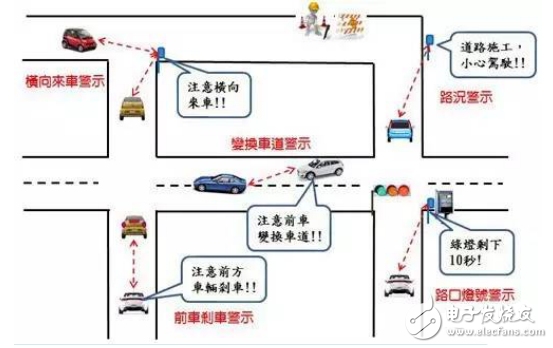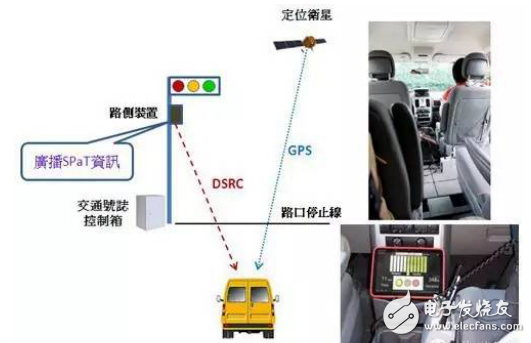The functionality and security of connected cars will jump dramatically. 4G and Dedicated Short Range Communication (DSRC) technology enables vehicles in motion to be linked to mobile devices, surrounding vehicles, roadside infrastructure and cloud systems for a variety of intelligent applications such as vehicle diagnostics, collision warning and incident notification. Improve the safety of driving the car, and get the car factory to expand the adoption.
ConnectedCar is one of the hot research topics for intelligent transportation in recent years. Its development goal is to create a safer, smarter and more environmentally friendly transportation vehicle.
Among all the conditions required to build a connected car, ConnecTIvity is one of the important elements of its realization. Connected cars can provide more convenience by driving vehicles with vehicles (VehicletoVehicle), Vehicle to Roadside units (VehicletoRoadsideUnit), traffic signs, cars and smart phones or other devices. Adding security to your journey.
The connectivity applications of connected cars can be roughly divided into the following three types:
Car and car (V2V) link
Communicate with each other through vehicles to prevent traffic accidents and reduce traffic accidents.
Link between vehicle and roadside (V2R) and infrastructure (V2I)
It provides real-time and regional road information for the owner, facilitating the journey quickly and easily.
Links to cars and other smart devices/systems
Connected to other user systems, providing real-time, uninterrupted service, making the ride environment and journey safer and more comfortable.
The number of new vehicles currently deployed in the Internet of Vehicles is gradually increasing, but most application services only contact the back-end system of the vehicle manufacturer for assistance, or provide navigation and various voice services during driving; but if it involves a higher level, such as Application functions related to safe driving are still rare.
The data shows that about 33,000 people are killed and 2.3 million injured in the United States each year due to traffic accidents. In February 2014, the National Highway Traffic Safety Administration (NHTSA) publicly stated that it would recommend that US President Obama should be in the new Light Vehicle before leaving his post in 2017. It is equipped with a V2V communication system to prevent car accidents.
The National Highway Traffic Safety Administration will also publish a preliminary research report on the new system. It is estimated that if this new regulation is implemented, it will help the United States prevent 80% of car accidents caused by non-drunk driving or vehicle parts failure.
WAVE/DSRC will become standard equipment for new cars
Regarding the communication between the car and the car, the United States plans to implement the Dedicated Short Range CommunicaTIons (DSRC) technology. Although NHTSA does not clearly indicate which DSRC communication technology will be used, the DSRC communication technology that will be adopted in the previous research and development and field test in the United States should be 5.9GHz vehicle environment wireless access (WAVE)/DSRC. Contains IEEE1609 related protocols and IEEE802.11p technology.
The effective communication distance of the DSRC is several hundred meters. The vehicle transmits information such as position, speed and direction to other vehicles on the road through the DSRC at a frequency of ten times per second. When the vehicle receives signals from other vehicles, if necessary (for example) There are other vehicles on the corner of the road, or the vehicle in front suddenly hits the car and changes lanes. The interior device will remind the driver of the flashing signal, voice reminder or seat, steering wheel vibration, etc. (Figure 1).

Figure 1 The car provides DSC safety warning information.
To this end, General Motors (GM) has patented the car seat vibration technology, and Ford has also developed steering wheel vibration technology to match the vehicle interconnection communication system that will be forced to install.
In addition, if the road facilities such as the traffic management number use DSRC communication technology, they can also talk to the vehicles on the road to inform the driver of the relevant road conditions (such as road congestion, construction, road potholes, etc.) so that the driver can divert in advance. Or pay attention.
DSRC establishes the basis of automatic driving
The Michigan Transportation Bureau (MDOT) conducted a real vehicle demonstration test in Oakland, Michigan in 2011. In this real vehicle demonstration test, there were nearly 3,000 cars, buses, trucks and motorcycles equipped with DSRC communication devices. The car participates in the test of V2V and V2I communication utility.
The test first connects the roadside device of the vehicle and the intersection traffic signal control device. Through the DSRC communication technology, the intersection traffic light signal transmits the signal phase and timing (SignalPhaseandTiming, SPaT) information to the vehicle, and the vehicle is based on the differential global satellite positioning system (DGPS). / Global Navigation Satellite System (GNSS) to make accurate positioning, according to its driving information (vehicle speed, forward direction, stop line distance) and environmental information (segment length, road speed limit), after estimation, provide vehicle driver speed recommendations, Achieve equal safety and efficiency (Figure 2).

Figure 2 Schematic diagram of SPaT broadcast via DSRC
At the International Consumer Electronics Show (CES) held in the United States in January 2014, Ford, General Motors and other major automobile manufacturers showed their most advanced V2V communication technology. According to relevant research and development personnel, the function of this system is far greater than the technology of vehicle radar and infrared transmission induction, and will become the basis of future self-driving cars; and when the technology enters the commercial stage, the new car is only required to be installed. More than $100 in additional costs.
Although the DSRC is supported by Ford, GM, Honda, Hyundai, Mercedes-Benz, Nissan, Toyota, and many other automakers, the United States Department of Transportation Transportation, USDOT) officials said that the new technology will take at least 10 years to be widely used; in addition, although this technology is expected to reduce traffic accidents, it may also cause controversy over personal privacy. Automobile automation experts said that through the DSRC system, car manufacturers and other related institutions will be able to understand the owner's every move, and the follow-up of the technology in application and regulation is still worth observing.
In addition to the United States, European countries and Australia have also begun to research and test DSRC communication technology and develop new application areas; in Portugal, it uses more than 500 vehicles and Road Side Unit (RSU) to construct The Vehicle Mesh Network covers the entire city and serves as a data transfer for the port terminal management system.
Maskking(Shenzhen) Technology CO., LTD , https://www.maskkingtech.com
![<?echo $_SERVER['SERVER_NAME'];?>](/template/twentyseventeen/skin/images/header.jpg)